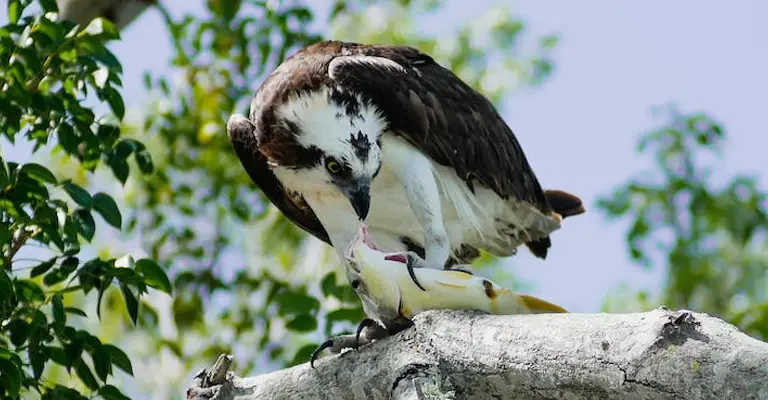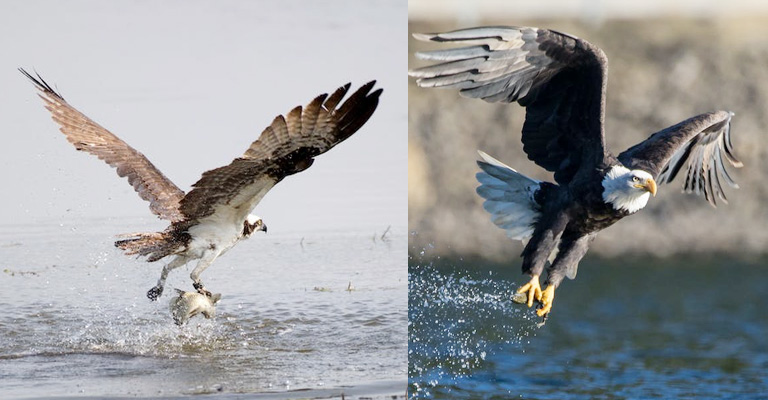The majestic and awe-inspiring eagle holds a special place in the hearts and minds of people around the world. Among the numerous eagle species that exist, the Fish Eagle and the Bald Eagle stand out as two remarkable representatives.
While both are renowned for their exceptional hunting skills and regal appearance, they exhibit distinct characteristics and inhabit different regions of the world.
In this comparative analysis, we will delve into the unique features and behaviors of these remarkable birds of prey, shedding light on the similarities and differences that set them apart.
Join us as we explore the captivating world of the Fish Eagle and the Bald Eagle, uncovering the intriguing dynamics of these avian powerhouses.

Fish Eagle
The African fish eagle (Haliaeetus Vocifer) is a large bird, measuring around 70 to 80 centimeters (27 to 31 inches) in length and weighing between 2.5 to 3.5 kilograms (5.5 to 7.7 pounds).
It possesses a wingspan of approximately 2 meters (6.5 feet), allowing it to glide gracefully through the sky. The fish eagle displays sexual dimorphism, with females being larger than males.
Habitat and Distribution in Sub-saharan Africa
The fish eagle is predominantly found near freshwater habitats throughout sub-Saharan Africa. It favors areas such as rivers, lakes, and lagoons, where it can easily access its main food source: fish.
The abundance of water bodies in this region provides suitable nesting sites and ample hunting opportunities for the fish eagle population.
Adaptations for Fishing, Including the Hook-shaped Beak and White Head

The fish eagle has several adaptations that enhance its fishing prowess. Its beak is uniquely shaped like a hook, allowing it to grasp and hold onto slippery fish effectively.
This specialized beak is crucial for catching prey in the water. Additionally, the fish eagle’s distinctive white head serves a functional purpose. When perched on a tree branch or flying above the water, the white head blends with the sky, making it less visible to fish swimming below.
Diet and Hunting Strategies of the Fish Eagle
As its name suggests, the African fish eagle primarily feeds on fish, which make up a significant portion of its diet. It skillfully scans the water’s surface from a vantage point, often perched on a tree branch or rocky outcrop, looking for fish near the surface.
Once a potential target is spotted, the fish eagle swoops down with great speed and accuracy, using its powerful talons to snatch the fish from the water.
It is a formidable hunter, capable of capturing fish weighing up to 2 kilograms (4.4 pounds) or even larger.
The combination of its physical adaptations, habitat preferences, and hunting techniques makes the African fish eagle an exceptional predator in its aquatic environment.
Its elegant flight, piercing call, and remarkable fishing skills have made it a symbol of Africa’s diverse and awe-inspiring wildlife.
Bald Eagle

The bald eagle (Haliaeetus Leucocephalus) is a large raptor, measuring approximately 76 to 102 centimeters (30 to 40 inches) in length, with a wingspan ranging from 1.8 to 2.3 meters (6 to 7.5 feet).
It displays sexual dimorphism, with females being larger than males, similar to the fish eagle. The most distinguishing feature of the bald eagle is its white head, contrasting with its dark brown body, and its sharp, yellow, hook-shaped beak.
Habitat and Distribution in North America
The bald eagle is widely distributed across North America, with a habitat range that extends from Alaska and Canada down to Mexico. It thrives in diverse environments, including coastal areas, lakes, rivers, and large bodies of water such as reservoirs and wetlands.
Bald eagles prefer areas with an abundant food supply and suitable nesting sites, often choosing tall trees near water bodies for their nests.
Fishing Abilities and Similarities to the Fish Eagle

Similar to the fish eagle, the bald eagle is known for its remarkable fishing abilities. It possesses sharp, strong talons and powerful wings that enable it to swoop down and snatch fish from the water’s surface with precision and agility.
The bald eagle’s hunting techniques share similarities with the fish eagle’s, showcasing their shared adaptation for capturing aquatic prey.
Variation in Diet and Hunting Techniques of the Bald Eagle
While fish form a significant portion of the bald eagle’s diet, it exhibits a more varied feeding behavior compared to the fish eagle. In addition to fish, bald eagles also consume a range of other prey, including small mammals, waterfowl, and carrion.
They are opportunistic hunters, often scavenging for food and exploiting various food sources within their habitats. Bald eagles employ different hunting techniques depending on their prey, including aerial hunting, perch hunting, and scavenging.
The bald eagle’s adaptability, wide distribution, and cultural significance as a national symbol of the United States make it an iconic and cherished species.
Its impressive physical attributes, diverse diet, and versatile hunting strategies contribute to its success as a top predator in North America’s ecosystems.
Physical Similarities and Differences

Identifying a fish and a bald eagle is oftentimes difficult because of their similarities. Here are some points that will help you understand those facts.
Comparison of Body Size and Sexual Dimorphism in Both Species
Both the fish eagle and the bald eagle display sexual dimorphism, where females are larger than males. This characteristic is observed in many bird species and is believed to be related to reproductive roles and resource availability.
In both species, the size difference between males and females can be significant, with females being approximately 25% larger than males. This sexual dimorphism is an important factor in identifying and distinguishing between the two genders of these magnificent eagles.
Their Dark Brown Bodies, White Heads, and Yellow Beaks
Both the fish eagle and the bald eagle exhibit a similar color pattern. They possess dark brown bodies, often described as chocolate brown or mahogany, which serve as effective camouflage against the surrounding environment.
Their distinctive white heads are another shared feature, contrasting sharply with their dark bodies. This striking contrast is visually captivating and aids in identification, especially during flight or perched on trees.
Additionally, both species have yellow beaks that are hook-shaped, providing a strong and efficient tool for capturing and manipulating prey.
Significance of the White Head in Both Species and Its Potential Advantages in Hunting
The presence of a white head in both the fish eagle and the bald eagle carries functional significance. While the exact advantage may differ between the two species, the primary function is believed to be related to hunting.
The white head serves as a visual deception technique, especially when observed from below against the bright sky or water. It can confuse and startle prey, making it harder for them to detect the approaching predator.
This adaptation allows the eagles to better conceal themselves during hunting activities and increase their chances of successful capture.
Geographic Distribution and Ecological Roles
In the context of geographic distribution and ecological roles, these two species have a lot of differences. Some of them are discussed below.
Geographical Ranges: Fish Eagle Vs. Bald Eagle
The fish eagle is primarily found in sub-Saharan Africa, inhabiting a range of countries across the continent. Its distribution spans from countries such as Senegal and Sudan in West Africa to South Africa and Mozambique in the South.
On the other hand, the bald eagle is native to North America, with its range extending from Alaska and Canada through the contiguous United States and down to Mexico.
These distinct geographical ranges reflect the different continents and regions where these eagles have evolved and adapted to thrive.
Impact on The Ecosystems and the Local Food Chains
The fish eagle is closely associated with freshwater habitats, such as rivers, lakes, and lagoons. These ecosystems provide an abundant food source in the form of fish, which make up a significant portion of the fish eagle’s diet.
By hunting fish, the fish eagle plays a crucial role in regulating fish populations and maintaining ecological balance within freshwater ecosystems.
On the other hand, the bald eagle is strongly tied to coastal areas, large lakes, and rivers in North America. These habitats offer a diverse range of prey, including fish, waterfowl, and carrion.
The presence of bald eagles influences the dynamics of local food chains by controlling populations of fish and waterfowl species, scavenging on carcasses, and competing with other avian predators.
Importance of Freshwater Habitats for Fish Eagles and Coastal Areas for Bald Eagles
Freshwater habitats are of utmost importance for the survival of fish eagles. These habitats provide not only a reliable food source but also suitable nesting sites, perches, and breeding grounds for the species.
Healthy and intact freshwater ecosystems are crucial for maintaining viable fish populations and sustaining the fish eagle population.
Similarly, coastal areas are vital for the survival of bald eagles. Coastal environments offer diverse marine and estuarine ecosystems that support a wide variety of prey species, including fish, waterfowl, and marine mammals.
Coastal areas also provide nesting sites on cliffs, trees, or man-made structures near the water, allowing the bald eagles to establish their territories and raise their young.
Convergent Evolution and Shared Adaptations
Convergent evolution occurs when different species face similar selective pressures and environmental conditions, leading to the independent development of similar traits or adaptations.
In the case of the fish eagle and the bald eagle, both species have evolved similar physical characteristics, such as dark brown bodies, whiteheads, and yellow, hook-shaped beaks.
These shared traits are not due to a common ancestor, but rather a result of the selective pressures associated with their similar hunting habits and ecological roles.
The Evolutionary Pressures That Led to Similar Physical Characteristics
The similar physical characteristics of the fish eagle and the bald eagle are a result of their shared ecological niche as fish-catching raptors. Both species rely heavily on fishing as a primary food source and the adaptations they possess aid in their hunting success.
The dark brown body coloration provides effective camouflage, allowing them to blend with their surroundings during hunting activities. The white head serves as a visual deception, confusing their prey and making the eagles less visible against the bright sky or water.
The yellow, hook-shaped beaks are specialized tools for grasping and manipulating fish, enabling efficient capture. These shared physical characteristics have evolved independently in the fish eagle and the bald eagle due to the similar selective pressures of their aquatic hunting lifestyles.
The advantages provided by these adaptations have increased their hunting efficiency and improved their chances of survival in their respective environments.
Other Animals Demonstrating Convergent Evolution in Different Environments
Convergent evolution can be observed in various animal species across different environments. One notable example is the convergence between the marsupial sugar gliders in Australia and the flying squirrels in North America.
Despite being separated by vast distances and belonging to different mammalian lineages, both species have independently evolved similar adaptations for gliding and arboreal lifestyles, including a patagium (a membrane of skin) that allows them to glide through the air. Another example is the convergence between the cacti in North America and the euphorbias in Africa.
These two groups of plants, found on different continents and belonging to different plant families, have independently evolved similar succulent stem structures, spines, and water-storing abilities as adaptations to arid and desert environments.
Cultural Significance and Conservation Status
Fish eagles and bald eagles have significant cultural importance in their respective regions. In many African cultures, the fish eagle is revered for its majestic presence and powerful hunting skills.
It is often considered a symbol of strength, freedom, and wisdom. In some African myths and folklore, the fish eagle represents a messenger between humans and the spirit world.
Similarly, the bald eagle holds immense cultural significance, particularly in North America. It is the national bird and symbol of the United States, representing freedom, courage, and resilience.
The bald eagle has deep historical and spiritual connections to Native American tribes, who view it as a sacred and revered creature, often associated with spirituality and protection.
Current Conservation Status and Threats Faced by Both Species
The conservation status of the fish eagle and bald eagle varies, with efforts focused on ensuring their long-term survival in the face of numerous threats.
The African fish eagle is listed as a species of Least Concern by the International Union for Conservation of Nature (IUCN), indicating a relatively stable population.
However, localized declines and habitat loss due to human activities, such as deforestation and pollution, pose significant threats to their survival.
The bald eagle, on the other hand, has made a remarkable recovery from near extinction. It was previously listed as endangered but has since been downgraded to a species of Least Concern.
This success is largely attributed to extensive conservation efforts, including habitat protection, restriction of harmful pesticides, and legal protection.
Conservation Efforts and Initiatives to Protect These Majestic Predators
Conservation efforts for both the fish eagle and the bald eagle are critical for their continued survival. Various initiatives and organizations are working towards their protection and habitat conservation.
These efforts include establishing protected areas, promoting sustainable fishing practices, and raising awareness about the importance of these species within their ecosystems.
Additionally, international conventions, such as the Convention on International Trade in Endangered Species (CITES), regulate the trade and protection of these eagles and their parts to prevent illegal wildlife trafficking.
Local communities, governments, and conservation organizations collaborate to monitor populations, conduct research, and implement conservation strategies.
Public education and outreach programs play a vital role in raising awareness about the significance of these eagles and the need for their conservation.
Differences Between the Eagle and the Bald Eagle
| Aspect | Fish Eagle | Bald Eagle |
| Scientific Name | Haliaeetus vocifer | Haliaeetus leucocephalus |
| Geographic Range | Sub-Saharan Africa | North America |
| Primary Habitat | Freshwater habitats (rivers, lakes, lagoons) | Coastal areas, large lakes, rivers |
| Range of Beak | Yellow, hook-shaped | Yellow, hook-shaped |
| Head Color | White | White |
| Body Color | Dark brown | Dark brown |
| Hunting Techniques | Swoops down to snatch fish from the water | Swoops down to snatch fish, waterfowl, carrion |
| Primary Prey | Fish | Fish, waterfowl, small mammals, carrion |
| Size Dimorphism | Females are 25% larger than males | Females are 25% larger than males |
| Nesting Preference | Near freshwater habitats | Near water bodies, coastal areas |
| Cultural Significance | Revered for strength and wisdom | National bird and symbol of the United States |
| Conservation Status | Least Concern | Least Concern |
| Habitat Preference | Freshwater habitats | Coastal areas, wetlands |
| Nesting Sites | Trees, cliffs | Trees, cliffs, man-made structures |
| Conservation Threats | Habitat loss, pollution | Habitat loss, pollution, electrocution |
| IUCN Listing | Least Concern | Least Concern |
| Ecological Role | Regulates fish populations in freshwater ecosystems | Controls fish and waterfowl populations |
| Hunting Camouflage | Whitehead aids in confusing prey | Whitehead aids in camouflage while hunting |
| Symbolic Significance | Messenger between humans and the spirit world (in African cultures) | Symbol of freedom and courage (in the U.S.) |
| Wing Span | Approximately 2 meters (6.5 feet) | Ranges from 1.8 to 2.3 meters (6 to 7.5 feet) |
FAQs
No, fish eagles are primarily found in sub-Saharan Africa, inhabiting freshwater habitats such as rivers, lakes, and lagoons. In contrast, bald eagles are native to North America and inhabit coastal areas, large lakes, and rivers.
Yes, both fish eagles and bald eagles are known to undertake migratory movements. However, the extent and patterns of migration vary among populations and geographic regions.
Fish eagles have an average lifespan of around 15 to 20 years in the wild, although some individuals may live longer. Bald eagles have a longer lifespan, with individuals living up to 20 to 30 years or more in the wild.
Currently, neither the fish eagle nor the bald eagle is classified as endangered. The fish eagle is listed as a species of Least Concern by the IUCN, while the bald eagle is also listed as Least Concern in most regions, following successful conservation efforts.
Both fish eagles and bald eagles are apex predators in their respective ecosystems and generally have no natural predators. However, in rare instances, young or injured eagles may fall prey to larger predators such as other birds of prey or mammalian predators.
Wrapping Up
The fish eagle and the bald eagle are remarkable raptors with distinct characteristics and ecological roles.
While they share some physical similarities, their geographic distribution, hunting habits, and cultural significance set them apart.
Conservation efforts are essential to protect these majestic predators and the habitats they depend on for their survival.
However, I think that you’ve understood the differences between these two types of eagles properly. Still, if you have any more confusing points, please let us know. We’ll definitely try to solve it. Thank you for your time.